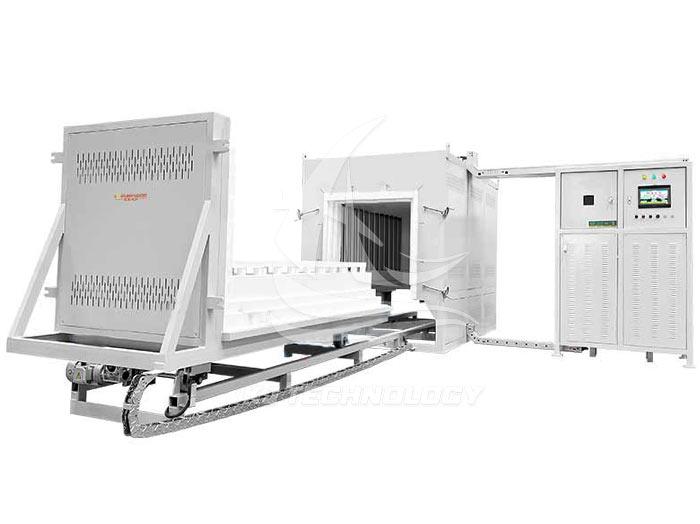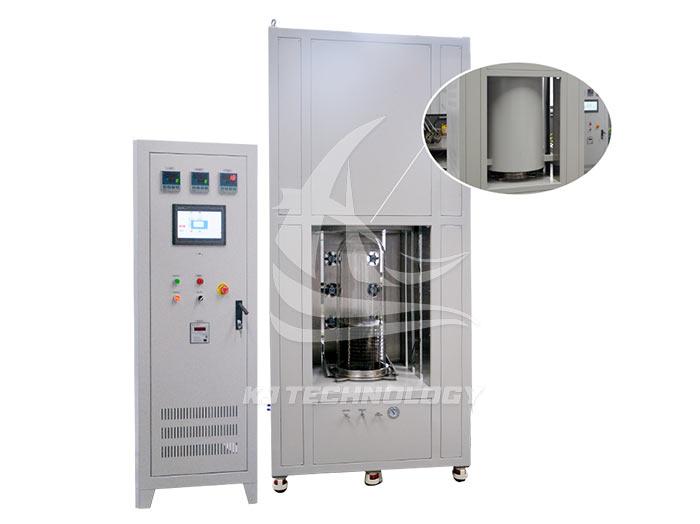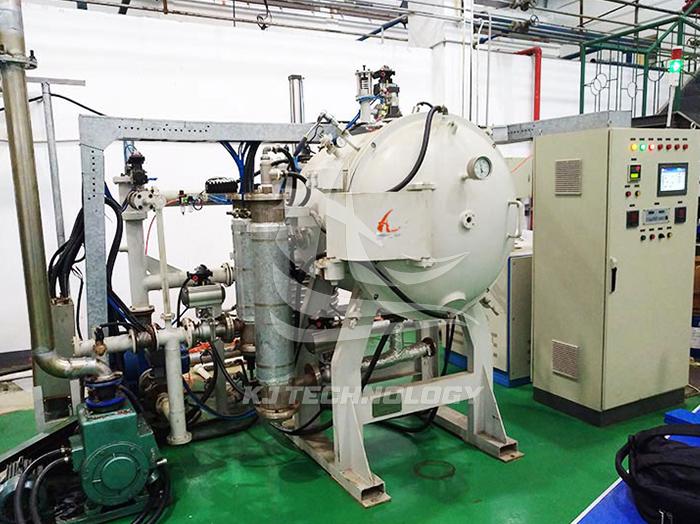Application of Vertical High Vacuum Hot Pressing Electric Furnace in Powder Metallurgy Industry
 08-20-2025 Author: KJ technology
08-20-2025 Author: KJ technology
The vertical high vacuum hot pressing electric furnace is widely and crucially used in the powder metallurgy industry. Through the synergistic effect of vacuum environment, high-temperature heating, and mechanical pressure, it significantly improves the performance and production efficiency of metal powder products. The specific applications and advantages are as follows:
1. Core application areas
Preparation of high-performance metal parts
Complex shaped parts: Hot pressing technology can press metal parts with complex shapes, such as turbine rotors, cutting tools, etc., to meet the demand for high-precision and high-performance parts in aerospace, automotive and other fields.
Difficult to melt metal processing: For metals with high melting points and hardness (such as tungsten, molybdenum, and their alloys), hot pressing technology promotes particle bonding through high temperature and pressure, achieves densification sintering, and improves material strength and toughness.
Hard alloy production
Cutting tools and molds: Hot pressing sintering is the main preparation method for hard alloys such as tungsten carbide cobalt alloys. By optimizing pressure and temperature parameters, the grain size can be controlled, and the wear resistance of cutting tools and mold life can be improved.
High density products: Pressure assisted sintering significantly increases the density of hard alloys (up to 99% or more), reduces porosity, and enhances material hardness and impact resistance.
Development of special alloys
High temperature alloy: used in high-temperature environments such as aircraft engine blades and gas engine components. The hot pressing process suppresses grain growth, improves material high-temperature strength and oxidation resistance.
Corrosion resistant alloys: such as nickel based alloys, hot pressing sintering can eliminate internal defects and improve the corrosion resistance of materials in harsh environments.
2. Technical advantages
Improve material density
Vacuum environment: isolate active gases such as oxygen and nitrogen to prevent oxidation or decomposition of metal powders, ensuring the purity of the sintering process.
Pressure assistance: By applying pressure through a hydraulic system (usually 5-100MPa), it promotes particle rearrangement and pore elimination, resulting in a product density of over 99%, much higher than that of normal pressure sintering (usually 90% -95%).
Optimize organizational structure
Inhibiting abnormal grain growth: Pressure restricts the free growth of grains, avoiding increased brittleness caused by coarse grains, and improving material toughness and fatigue life.
Fine grain strengthening: The grain size of metal products sintered by hot pressing can be controlled within 1-5 μ m, and the strength and hardness are improved through the fine grain strengthening mechanism.
Reduce sintering temperature and time
High temperature and pressure synergy: High temperature puts metal powder in a thermoplastic state, while pressure promotes particle contact and diffusion, significantly reducing sintering temperature (100-300 ℃ lower than normal pressure sintering).
Rapid densification: Pressure accelerates the densification process, shortens insulation time (from several hours to 30-60 minutes), and reduces single batch production time by 30% -50%.
Adapt to complex component systems
Multi component alloys: The hot pressing process can uniformly disperse various metal powders, avoiding component segregation, and is suitable for preparing complex component systems such as gradient materials and composite materials.
Adding sintering additives: By adding a small amount of additives (such as cobalt and nickel), the sintering temperature can be further reduced and material properties can be improved.
3. Typical case
Application in aviation manufacturing enterprises
Case: A certain aviation enterprise used a vertical high vacuum hot pressing electric furnace to prepare alloy materials. By optimizing pressure and temperature parameters, the material strength increased by 20% and toughness increased by 15%. It was successfully applied in the manufacturing of engine blades, significantly improving product reliability.
Effect: The hot pressing process increases the blade density to 99.5%, prolongs the fatigue life to twice that of traditional processes, and reduces maintenance costs.
Production of Hard Alloy Cutting Tools
Case: A certain tool manufacturer used hot pressing sintering technology to prepare tungsten carbide cobalt alloy tools. By controlling the pressure to 30MPa and temperature to 1450 ℃, the tool hardness reached 92HRA and the wear resistance increased by 30%.
Effect: The service life of cutting tools has been extended to 1.5 times that of traditional processes, significantly improving market competitiveness.
Development of special alloys
Case: A research institution developed a nickel based high-temperature alloy using a hot pressing electric furnace. By adding 0.5% rhenium element and sintering at 1250 ℃ and 50MPa, the material's high-temperature strength increased by 25% and oxidation resistance increased by 40%.
Effect: The alloy has been successfully applied to gas turbine components, with a working temperature increased to 1100 ℃ and an efficiency improvement of 10%.
4. Process flow
Raw material preparation: Mix metal powders (such as tungsten carbide and cobalt powder) in proportion, add a small amount of sintering aids (such as paraffin), ball mill evenly, and then dry.
Loading and vacuuming: Load the powder into a graphite mold, place it in the furnace, and vacuum it to 10 ⁻³ -10 ⁻⁵ Pa to remove air and moisture.
Heating and pressurization:
Heating stage: Heat up at a rate of 5-10 ℃/min to the sintering temperature (such as 1400-1500 ℃ for tungsten carbide cobalt alloy).
Pressure stage: After the temperature reaches the target value, apply pressure (usually 20-50MPa) and maintain it for 30-120 minutes.
Cooling and demolding: After cooling to room temperature in the furnace, take out the sample for subsequent processing (such as cutting and polishing).
5. Future Trends
Intelligent control: Real time monitoring and adjustment of process parameters are achieved through PLC and human-machine interface, improving production stability and repeatability.
Energy saving and environmental protection: Optimize furnace structure and heating elements (such as silicon carbide rods) to reduce energy consumption and carbon emissions.
Multifunctional: Integrated with atmosphere protection, rapid cooling and other functions to meet the needs of more material systems.








